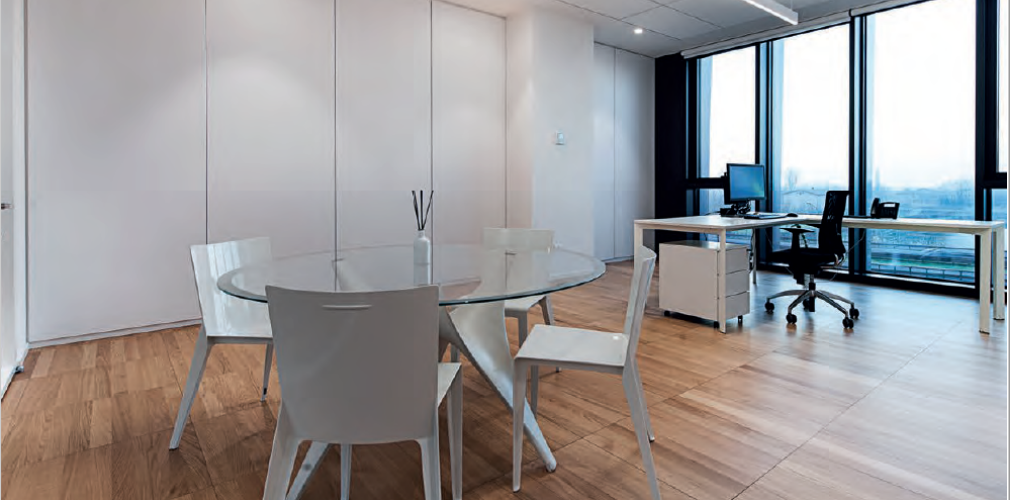Increasingly, the boundaries between workplace and living space are blurring. How can the ceiling play its part in creating an equilibrium? Isabel Blanco discusses.
Remote working is on the rise. Managers are seeing the benefits of fostering wellbeing in the office. Just as we’re working longer hours at work, we’re encouraged to take more time out, in breakout spaces or simply stepping outside. It’s all a shifting trend towards the fluidity of the working day and this is linked to wellbeing.
People seek spaces they can enjoy at work – points to disconnect from the endless flow of tasks, as well as spaces that are brighter and more inspiring. The aim of this is to improve their day-to-day wellbeing and managers are fully aware of the benefits this can bring. Happier employees are naturally more productive. They’re also more loyal to an employer who understands the importance of a good work-life balance. But what does this look like in practice?
Make yourself at home
Gone are the days of the uniform, featureless box-offices and cubicle farms. After all, when the average UK worker spends around 3,507 days of their lives in the workplace, we need to ensure it’s a place we enjoy.
Increasingly, managers are looking to bring the outdoors inside. Biophilic offices, green spaces and nature play an ever-larger role in workplace design, creating brighter, airier spaces. Open-plan offi ce layouts are more or less the norm today, with the intention of fostering closer collaboration and enhancing wellbeing.
For both of these trends, the critical element is natural light. Large windows and glazed areas are, of course, key to this but ceilings themselves need high levels of refl ectance to aid the spread of light. Coupled with using materials such as mineral tiles that improve indoor air quality and we’re already looking at a more desirable place in which to spend a third of our lives.
Wellbeing, daylight and indoor air quality are just part of the story. In these open-plan workspaces, we also need effective zoning solutions: Breakout areas for relaxation, meeting areas for collaborative/confi dential work, quiet spaces for focus and concentration. It’s crucial at the specifi cation stage that materials for acoustic zoning of spaces is accounted for. For example, mineral ceiling tiles with high levels of sound absorption/attenuation will be required for more private spaces, while ceilings that can direct sound within a certain radius will make for more effective collaboration.
It’s also important to specify ceiling solutions that mask sounds from the mechanical services in the plenum space. Good indoor air quality often relies on HVAC systems which can add unwelcome noise to a space. Working with a ceiling specialist can ensure this is minimised.
Most importantly, comfort is key. All aspects of the space’s architecture and interior design need to work together, from layout to materials to colours to furnishings. Only by doing so can we make workers feel at home while at work. Which brings us to what happens when people take their work home with them.
Creating the home office
Worldwide, it’s estimated that up to 70% of people work remotely at least once a week so it’s clear that residential projects need to factor inspaces enabling occupants to work with focus.
In terms of refurbishment/renovation projects, this often involves converting a bedroom/spare room, or even a particular corner of a common area, into a space where the inhabitant can work effectively, or undertake conference/video calls with colleagues, without disturbing other residents or neighbours. So, the ceilings in these spaces should refl ect the same acoustic/visual qualities as those of the workplace: Good levels of attenuation/absorption and brightness.
This situation is complicated for new-builds. Particularly in inner cities, where space is limited, multi-occupancy apartments and mixed-use developments need solutions that limit noise from the street and neighbours. Given the increased reliance on lightweight plasterboard solutions for walls, the ceiling here needs to play a larger role so greater focus needs to be placed on acoustic systems to create spaces conducive to home working.
Work and life – a ceiling apart
Just as boundaries between home and work are blurring, the way we approach creating each space is being inverted. We need to maximise wellbeing in the workplace – codes such as BREEAM and LEED demand it – so we’re bringing the visual and comfort aspects of the home into the working space. Conversely, at home, we need to design spaces that enable remotely effective working.
Whichever space we design for, maintaining the work-life balance needs to be foremost throughout the design, specification and build process.
Because work and life are just a ceiling apart.
FIND OUT MORE
The FIS Client Guide to Office Fit-Out and Refurbishment offers some useful advice and can be found at www.thefis.org/membership-hub/publications/client-guide-to-fit-out


